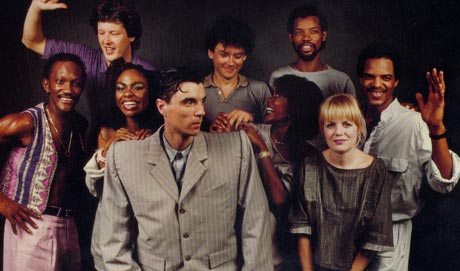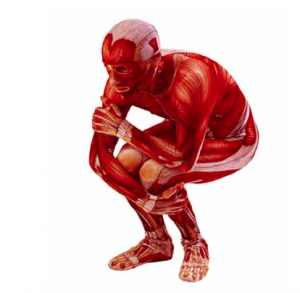
MOST PEOPLE KNOW THE Big Suit, but there were a lot of others. On one tour I wore a body suit that was painted to look like musculature. You could literally disappear in it – it covered my head and face and only my eyes and mouth were visible. You felt completely transformed in a costume like that, which is lot of fun… and it looks a little frightening.
This costume was made of stretch velvet – a tech material – and painted by the artisans at a midtown costume shop that also made costumes for Cats and other Broadway shows. Inside I also wore dancer’s underwear (kind of a jock strap) and an elastic belt that held my wireless receiver pack. The pack was the size of a pack of cigarettes and was upside down and covered in an unlubricated condom to keep my sweat out — a trick learned from the costume house. It even covered my feet, which were in little ballet slippers, I believe. So, this thing was like a second skin, a pretty weird feeling.
Back in the mid-Eighties I realised that if band members wore whatever they wanted the effects of the stage lighting would mean that who was seen and who was not on any given night became a crap shoot. If someone wore dark clothes they’d recede and if someone wore white they’d pop out. And if they wore something different the next night the opposite might happen. The lighting director on the shows couldn’t possibly readjust for every change so I decided to level the playing field a little. During the shows that were eventually filmed for Stop Making Sense I asked everyone to wear medium grey outfits, whatever they wanted style-wise (a questionable decision there) but always in medium grey. It worked, the evenness meant the effects of the various lighting cues and gags were always more consistent.
When I returned to playing more stripped down pop songs I had to deal with the prejudices in the rock world regarding costumes. In that world wearing what is perceived as an obvious costume or uniform is considered an affront to one’s individuality and therefore a compromise and a throwback to pre-rock performance traditions. Of course the people who complain about wearing a uniform the most are often the ones whose uniform of choice is a t-shirt and worn jeans. As if that isn’t a uniform as well! Conformism masquerading as non-conformity, if you ask me.
The first few years with Talking Heads we didn’t ‘need’ uniforms – because new bands become identified by their members and it’s assumed they are unified as a ‘team’. However, when I went out on my own with new players it became more important to at least give the impression that the new band was all working together and that their personalities and individual fashion senses were apart from the band. That they were there for the music and not for their individual egos.
A couple of tours ago when I toured with a small band and a six-piece string section I tried having jumpsuits made for everyone. These were meant to be stylish jumpsuits, based on one I bought at an Armani store in New York earlier that year (who did they think that shops there would buy a jumpsuit and wear it? Me, I guess).
Anyway, we couldn’t find exactly the same material and some of the elastic and construction may have been simplified a little, and as a result our copies looked more like pajamas rather than elegant one piece suits. Damn. We abandoned those after a short while. So, instead we then went for a cheaper off the rack uniform; Dickies, matching tops and bottoms in brown, dark blue and medium grey. Well, they weren’t exactly off the rack, they were slightly modified. The girls’ work shirts, and those of some of the boys, were tailored. I found some Levi’s poly twill pants that matched some of the Dickies tops that were slimmer cut, so those got mixed in too. Sometimes we all looked like a small convention of UPS workers and sometimes like we’d come to fix the plumbing. But when it worked it was a slimming, unifying look which was exactly what I was after.
With the large Latin band I toured with in the early Nineties we all wore white — as we do again now. Then the wearing of white was a subtle connection to the wearing of white in the traditions of Candomblé and Santeria, the Afro-Brazilian and Afro-Cuban religions in which some band members were involved. It was also not uncommon for salsa bands to wear a uniform, so that all came painlessly.

Everyone in Heaven wears white, don’t they? There’s a clothing locker at St Peter’s gate and you are issued your robes and a harp. My orisha [a spirit that is one of the manifestations of God in the Yoruba religious system], so I am told, is Obatala, who always wears white, so that is good too.
Ganda Suthivarakom is a musician, writer and culinary blogger based in Los Angeles.
This article was originally published in Vestoj On Material Memory.